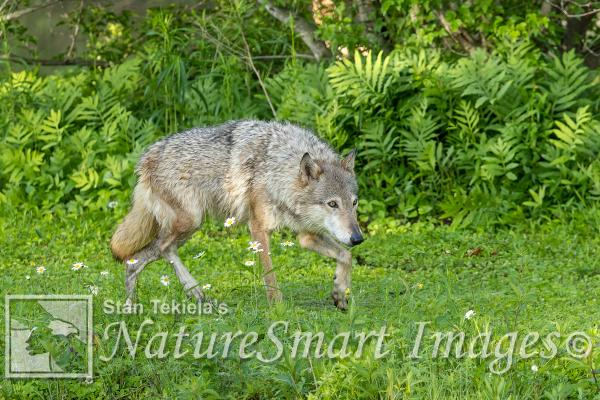View all of the titles in the
NatureSmart Bookstore

by Stan Tekiela
© NatureSmart
December 12, 2022
I just finished attending the International Wolf Symposium held in Minnesota. Every four years this amazing event brings biologist and researchers together to share their latest scientific findings and studies. Nearly 500 people who work with wolves and representing 18 countries gather for four days to share what they know about the Gray Wolf (Canus lupus). Well, that is not exactly true, there was many breakout sessions about Red Wolves (Canis rufus), Mexican Wolf (Canis lupus baileyi) and the Eastern Wolf (Canis lycaon).
I attended so many fabulous sessions that discussed everything from the unique genetics of wolves, to case studies done on male Alpha wolf displacement out of their pack and how this act might change the ecosystem. In addition, this is National Wolf Awareness Week in the U.S. (third week of October each year), so I thought I might summarize some of the nuggets of wolf wisdom I picked up over the past 4 days.
One presentation that stands out in my mind is the study of the wolves on Michipicoten Island. This is a small island, about 72 square miles, in Lake Superior that is part of Ontario Canada. The island is mostly forested and uninhabited by people. Researchers estimated that the population density of beaver on the island was higher than any other place in North America. In the not-so-distant past Caribou were relocated by people to this island and were growing in population. By 2010 there were about 450 to 500 Caribou on the island. The winter of 2014 was so cold that Lake Superior froze over allowing three to four wolves to cross over on the ice from the mainland and inhabit the island.
In a very short time, the wolves had reduced the number of Caribou on the island to the point that the remaining Caribou were taken off the island to preserve their genetics. By 2017 there was only 70 caribou left and the wolves started to starve to death. By 2018 all Caribou were gone leaving the wolves to hunt only American Beaver. At this time Isle Royal was looking to recolonizes with wolves after the wolf population died out on Isle Royal. Canadian officials caught the last fee remaining wolves on Michipicoten Island with the exception of two wolves, which eluded capture, and moved the rest to Isle Royal which had a strong Moose population.
By 2020 the beaver numbers started to rebound on Michipicoten Island, and it was thought that the remaining wolves on the island had died out. But in 2022 several sightings of wolves on Michipicoten Island came in and when researchers arrived, they found evidence of two wolves. Apparently the two wolves were making a living on eating only beavers and when they couldn’t catch beavers, they were eating Mountain Ash berries.
The presentation showed pictures of wolf tracks all around Mountain Ash trees that had berries and found scat containing the berries. So, these two wolves have survived 4 years without any Caribou to hunt, which is something thought to be impossible since it has always been assumed that wolves are tided to some kind of large animal prey such as deer or caribou.
Combine that with the recent publication of video and pictures on social media of wolves eating Blueberries in Voyagers National Park in Minnesota and you need to start to reconsider the resourcefulness of wolves in general.
Another study looked at Gray Wolves catching fish in rivers in northern Minnesota in the summertime. They showed camera trap video of wolves chasing down fish in rivers. Of course, this happened after dark and the wolves were catching and eating the fish. It has been known the wolves in the Pacific Northwest of British Columbia caught Salmon in streams, but this was the first evidence of wolves catching fish in fresh water away from any ocean.
All of these findings once again prove the point that things we have always considered to be true sometimes turn out to not be true and that we as people often oversimplify topics in order to try to understand. We never seem to consider the chance that we don’t know everything, and we definitely have not seen everything in nature. It seems to me that we don’t have a firm grasp on all the knowledge of nature, and we definitely always underestimate nature. Until next time…
Stan Tekiela is an author / naturalist and wildlife photographer who travels the U.S. to study and capture images of wildlife. He can be followed at www.instagram.com, www.faceboook.com and www.twitter.com. He can be contacted via his web page at www.naturesmart.com.
The nationally syndicated NatureSmart Column appears in over 25 cities spanning 7 states: Minnesota, Wisconsin, Michigan, Illinois, Ohio, New York and Pennsylvania. It is a bi-weekly column circulated to over 750,000 readers.
Wolves
Just the day before, a pack of wolves known as the Wapiti, had found a large bull bison that was weak and injured. Based on its size, this big boy was near the end of its lifespan and the winter weather was taking its toll. For a full day the wolves tried to approach the bison but when the bison...
Moose
It was one of those dark and cloudy winter days in Yellowstone National Park where the clouds are so heavy and low, you feel like you can reach up and touch the cloudy sky. A light wind helped to blow the falling snow with occasional gusts of wind causing swirls of fluffy white snow...
American Badger
It’s funny, I believe the average person knows more about the Honey Badger (Mellivora capensis), a critter of Africa and Southwest Asia than they do about the badger in our own backyard, the American Badger (Taxidea taxus). Social media has a lot to do with the Honey Badger phenomena and...
Backyard Bird Feeding
Winter bird feeding is one of the most common / popular hobbies in America. It is estimated that nearly 60 million Americans feed birds in their yards in winter or summer. That is about 40 percent of all American’s make backyard bird feeding part of their everyday activities. It’s...
Each year, during June and July, Stan Tekiela offers two world-class wildlife photography tours. Here's your chance to learn some tricks of the trade from a top professional.
View all of the titles in the
NatureSmart Bookstore
Check out Stan's latest photos at
NatureSmart Wildlife Images
Do you have any interesting wildlife in your backyard? Any nesting birds, deer, turkeys, reptiles, amphibians, or other unique wildlife? Or maybe a fox or coyote den?
If so, contact Stan at stan@naturesmart.com with your backyard wildlife. If he can get a good photo of the subject, he will send you a print of the photo to hang on your wall.
Order Prints and posters of Stan's photos at
» Prints & Posters
Hear Stan on radio stations all across the Midwest.
» More Info

When he's out in the field, Stan relies on his Vortex Razor binoculars and Vortex Razor spotting scope to help find the subjects for his award winning wildlife photography.

For thirty years, professional wildlife photographer Stan Tekiela has counted on Hunt's Photo and Video to provide him with professional photography equipment.
From tripods to camera bodies and lenses, Hunt's has been Stan's place for everything that he needs. Personal service and prompt shipping means Stan can count on Hunt's to support his professional wildlife photography career.


Professional Wildlife Photographer Stan Tekiela always uses Feeder Fresh in his seed feeders to help keep the feeders and food dry, clean and mold free.
He also uses Feeder Fresh Nectar Defender in all of his hummingbird feeders. It safely keeps nectar fresh longer.